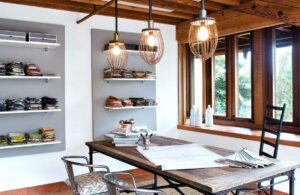Selecting the right industrial lamp for your home is a crucial aspect of creating a well-designed and functional living space. The importance of this decision cannot be overstated, as lighting not only sets the mood and ambiance of a room but also greatly influences its practicality and usability.
Industrial lamps, known for their distinctive blend of raw materials and contemporary design elements, have become increasingly popular in modern homes, offering a versatile and stylish lighting solution.
In this article, we will explore the importance of choosing the perfect industrial lamp to complement your home’s décor and meet your specific needs. Factors such as size, brightness, design, and energy efficiency play a vital role in making an informed decision. By carefully considering these aspects, you can successfully integrate an industrial lamp into your living space, enhancing its aesthetic appeal and functionality.
Join us as we delve into the significance of selecting the right industrial lamp, illuminating the path toward a beautifully lit and harmonious home environment.
How Do I Determine the Appropriate Size and Scale of an Industrial Lamp for My Room?
To determine the appropriate size and scale of an industrial lamp for your room, you should consider a few factors:
1. Space – Consider the size of the room where you plan to place the industrial lamp. If the room is small, you may want to choose a smaller lamp that won’t overwhelm the space. In bigger rooms, larger lamps can be used to create a focal point.
2. Fixture Shape – The shape of the lamp fixture will also play a role in determining its scale. A tall, narrow floor lamp, for example, will take up less visual space than a wide, round pendant light.
3. Function – Consider how the lamp will be used when determining the appropriate size. If you need the lamp for task lighting, like a desk lamp, it should be sized appropriately so that it can provide adequate lighting for the task.
4. Another lighting – If there are other light sources in the room, you’ll want to consider how the industrial lamp will fit in with them. A smaller lamp may be more appropriate if you already have ample overhead lighting, for example.
5. Furniture – Consider the furniture in the room, specifically the height of the other furniture pieces. Your industrial lamp should be proportional to the size of these pieces. A tall industrial lamp used next to a low sofa may make the couch feel dwarfed.
How Can I Ensure the Industrial Lamp I Choose Provides Adequate Lighting for My Needs?
To ensure that the industrial lamp you choose provides adequate lighting for your needs, consider these factors:
1. Brightness/Light Output – The light output, measured in lumens, is an essential factor to consider. Different lamps have varying light outputs, so make sure to select a lamp that provides enough light for the specific tasks to be performed in the room.
2. Color Temperature – The color temperature of a bulb also affects the mood and functionality of the light. If you’re using the lamp for reading or workspace task lighting, look for bulbs with a color temperature of 3000-4000K, which is close to natural daylight. If you’re using the lamp for creating a cozy atmosphere, look for bulbs with a warmer color temperature, such as 2200K.
3. Shade and Orientation – The orientation and position of the shade or bulb in the lamp affect the direction and brightness of the light. Adjustable arms, swiveling heads, or directional shades will likely provide more flexibility in directing light to a specific area.
4. Placement – The placement of the lamp is also important. Consider where the lamp will be located and how it will affect the existing lighting in the room. If the room already has excellent natural lighting, a dimmer lamp may be more appropriate instead of a bright one.
5. Wattage – Wattage is one measure of the amount of energy used by a lamp. Educate yourself on the appropriate wattage for lamps with the recommended brightness.
Can I Mix and Match Different Industrial Lamp Styles within the Same Space?
Yes, you can mix and match different industrial lamp styles within the same space as long as you follow some basic guidelines:
1. Choose lamps that complement each other – Select industrial lamps that share similar design elements, such as similar metal finishes or shapes. This helps create a cohesive look across the different styles.
2. Consider size and scale – Ensure that all the lamps you choose are proportional to the size of the furniture and the room as a whole. Avoid pairing oversized lamps with smaller pieces of furniture or rooms with low ceilings.
3. Match the color temperature – Make sure that the color temperature of the lights in each lamp is consistent. This prevents the lighting in the space from feeling disjointed.
4. Allow for contrast – Don’t be afraid to mix and match industrial lamps with other lamp styles. The contrast of different lamp styles can create visual interest and depth in your space.
5. Experiment with placement – Place different lamps at various elevations in your space. For example, a tall floor lamp next to a small desk lamp can create visual interest and break up the space.
Are there any Popular Brands or Designers Known for Their Industrial Lamp Designs?
1. Tom Dixon – Known for his sculptural lighting designs, Tom Dixon combines traditional industrial materials like brass and copper with contemporary design.
2. Anglepoise – An iconic British brand, Anglepoise is known for their adjustable desk lamps, originally developed in the 1930s for use in engineering and architecture.
3. Artemide – A design-driven Italian lighting manufacturer, Artemide creates a range of modern lighting designs, including some with an industrial aesthetic.
4. Louis Poulsen – A Danish lighting company that has been producing high-quality lighting designs since the 1920s, Louis Poulsen creates a range of contemporary and industrial lamps.

